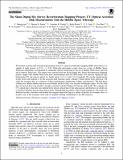Files in this item
The Sloan Digital Sky Survey Reverberation Mapping Project : UV–optical accretion disk measurements with the Hubble Space Telescope
Item metadata
| dc.contributor.author | Homayouni, Y. | |
| dc.contributor.author | Sturm, Megan R. | |
| dc.contributor.author | Trump, Jonathan R. | |
| dc.contributor.author | Horne, Keith | |
| dc.contributor.author | Grier, C. J. | |
| dc.contributor.author | Shen, Yue | |
| dc.contributor.author | Brandt, W. N. | |
| dc.contributor.author | Fonseca Alvarez, Gloria | |
| dc.contributor.author | Hall, P. B. | |
| dc.contributor.author | Ho, Luis C. | |
| dc.contributor.author | Li, Jennifer I-Hsiu | |
| dc.contributor.author | Sun, Mouyuan | |
| dc.contributor.author | Schneider, D. P. | |
| dc.date.accessioned | 2022-03-02T12:30:12Z | |
| dc.date.available | 2022-03-02T12:30:12Z | |
| dc.date.issued | 2022-02-28 | |
| dc.identifier | 278114119 | |
| dc.identifier | f011e916-444f-416e-ac70-b8dedc60317d | |
| dc.identifier | 000762037000001 | |
| dc.identifier | 85126308420 | |
| dc.identifier.citation | Homayouni , Y , Sturm , M R , Trump , J R , Horne , K , Grier , C J , Shen , Y , Brandt , W N , Fonseca Alvarez , G , Hall , P B , Ho , L C , Li , J I-H , Sun , M & Schneider , D P 2022 , ' The Sloan Digital Sky Survey Reverberation Mapping Project : UV–optical accretion disk measurements with the Hubble Space Telescope ' , Astrophysical Journal , vol. 926 , no. 2 , 225 . https://doi.org/10.3847/1538-4357/ac478b | en |
| dc.identifier.issn | 0004-637X | |
| dc.identifier.other | Jisc: 121349 | |
| dc.identifier.other | publisher-id: apjac478b | |
| dc.identifier.other | manuscript: ac478b | |
| dc.identifier.other | other: aas32034 | |
| dc.identifier.uri | https://hdl.handle.net/10023/24979 | |
| dc.description | Funding: Y.H., J.R.T., and G.F.A. acknowledge support from NASA grants HST-GO-15650 and 18-2ADAP18-0177 and NSF grant CAREER-1945546. K.H. acknowledges support from STFC grant ST/R000824/1. C.J.G. acknowledges support from NSF grant AST-2009949. Y.S. acknowledges support from NSF grants AST-1715579 and AST-2009947. P.H. acknowledges support from the Natural Sciences and Engineering Research Council of Canada (NSERC), funding reference number 2017-05983. L.C.H. was supported by the National Science Foundation of China (11721303, 11991052) and the National Key R&D Program of China (2016YFA0400702). | en |
| dc.description.abstract | We present accretion-disk structure measurements from UV–optical reverberation mapping (RM) observations of a sample of eight quasars at 0.24 < z < 0.85. Ultraviolet photometry comes from two cycles of Hubble Space Telescope monitoring, accompanied by multiband optical monitoring by the Las Cumbres Observatory network and Liverpool Telescopes. The targets were selected from the Sloan Digital Sky Survey Reverberation Mapping project sample with reliable black hole mass measurements from Hβ RM results. We measure significant lags between the UV and various optical griz bands using JAVELIN and CREAM methods. We use the significant lag results from both methods to fit the accretion-disk structure using a Markov Chain Monte Carlo approach. We study the accretion disk as a function of disk normalization, temperature scaling, and efficiency. We find direct evidence for diffuse nebular emission from Balmer and Fe ii lines over discrete wavelength ranges. We also find that our best-fit disk color profile is broadly consistent with the Shakura & Sunyaev disk model. We compare our UV–optical lags to the disk sizes inferred from optical–optical lags of the same quasars and find that our results are consistent with these quasars being drawn from a limited high-lag subset of the broader population. Our results are therefore broadly consistent with models that suggest longer disk lags in a subset of quasars, for example, due to a nonzero size of the ionizing corona and/or magnetic heating contributing to the disk response. | |
| dc.format.extent | 18 | |
| dc.format.extent | 2906908 | |
| dc.language.iso | eng | |
| dc.relation.ispartof | Astrophysical Journal | en |
| dc.subject | Accretion | en |
| dc.subject | Quasars | en |
| dc.subject | QB Astronomy | en |
| dc.subject | QC Physics | en |
| dc.subject | 3rd-DAS | en |
| dc.subject.lcc | QB | en |
| dc.subject.lcc | QC | en |
| dc.title | The Sloan Digital Sky Survey Reverberation Mapping Project : UV–optical accretion disk measurements with the Hubble Space Telescope | en |
| dc.type | Journal article | en |
| dc.contributor.sponsor | Science & Technology Facilities Council | en |
| dc.contributor.institution | University of St Andrews. School of Physics and Astronomy | en |
| dc.contributor.institution | University of St Andrews. St Andrews Centre for Exoplanet Science | en |
| dc.identifier.doi | 10.3847/1538-4357/ac478b | |
| dc.description.status | Peer reviewed | en |
| dc.identifier.grantnumber | ST/R00824/1 | en |
This item appears in the following Collection(s)
Items in the St Andrews Research Repository are protected by copyright, with all rights reserved, unless otherwise indicated.

